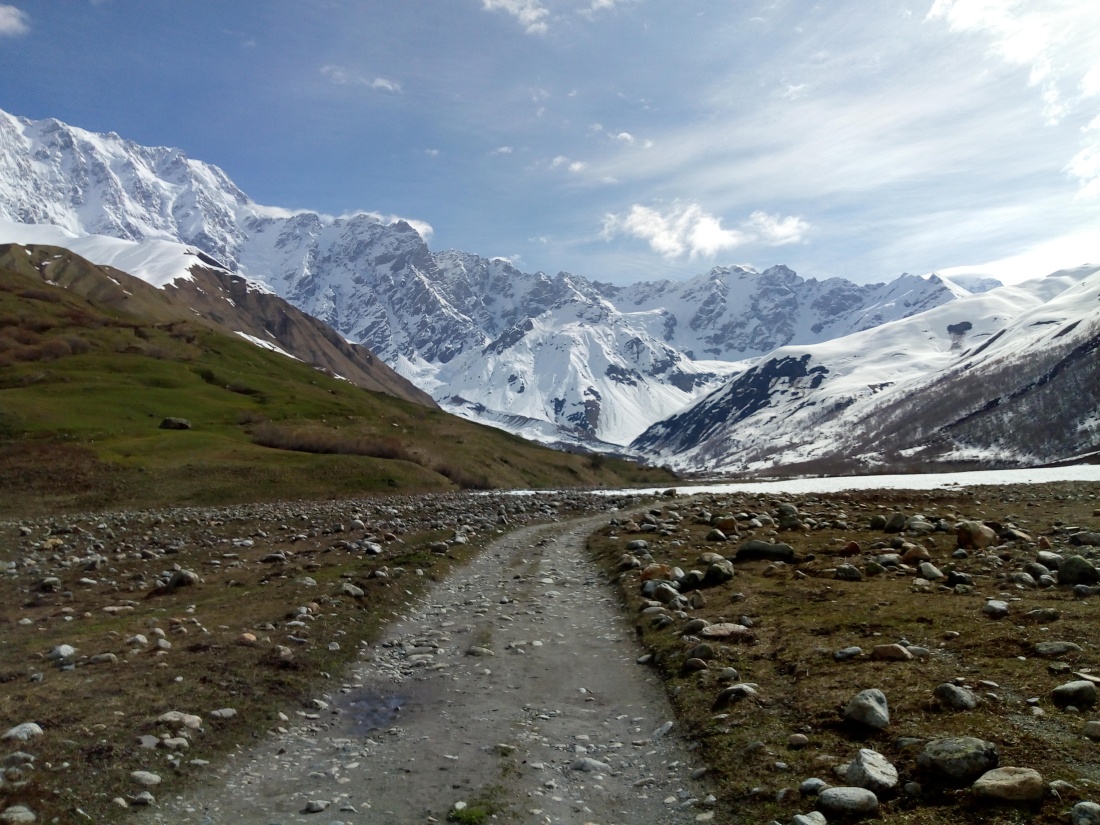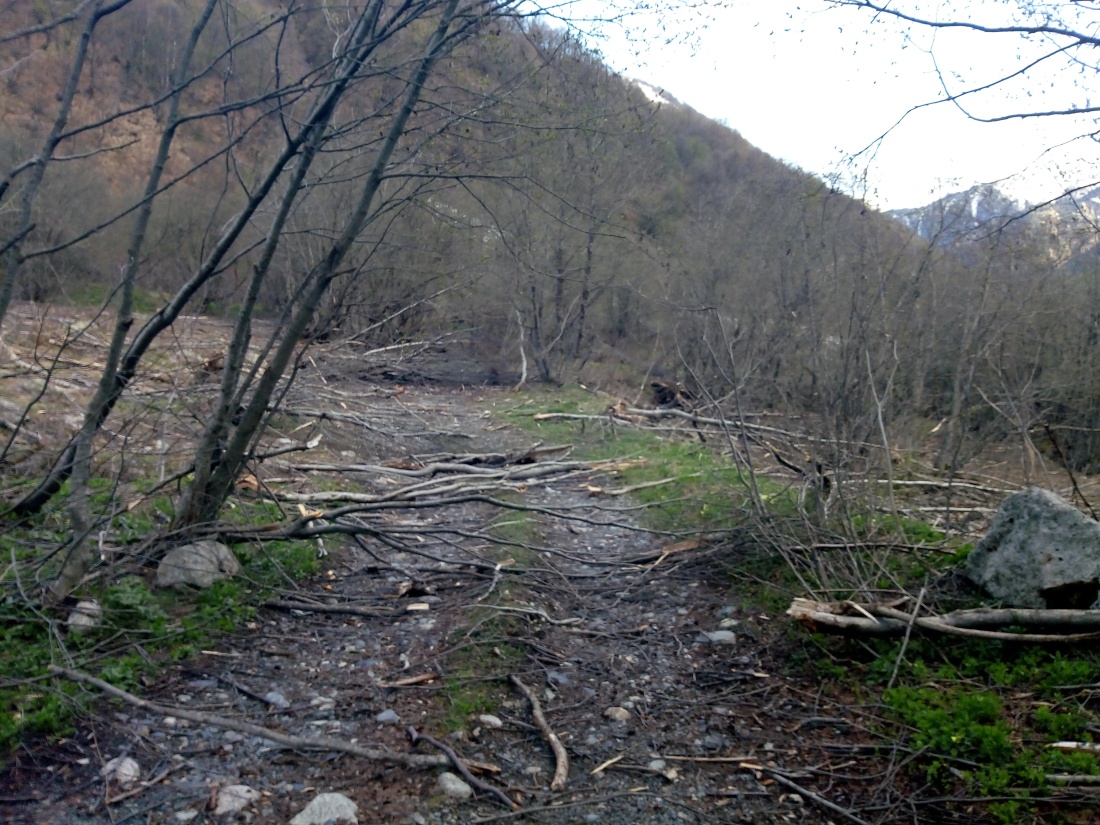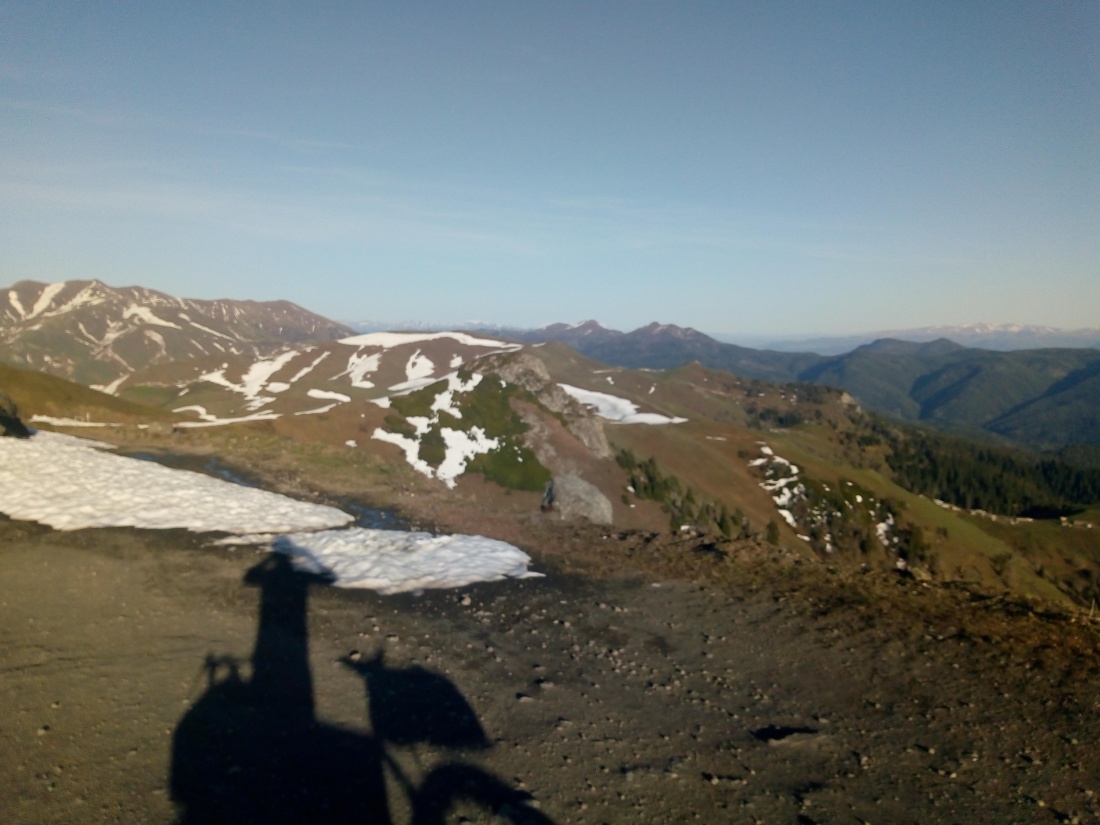I took my bike to Batumi’s most modern bike shop and asked if they had the bottom bracket I needed. They only had a knock-off Chinese version but, with little choice, I took it. They gave me the old bottom bracket, which was in a rather poor state. The damaged bearings had enabled dirt to get in and it was now encased in a layer of mud. About time for a replacement, then!

They also sorted out the bearings in my rear wheel, but unfortunately neither they nor the several other nearby bike shops had any wet chain lube. I’d have to live with this spray-on stuff a while longer.
From Batumi I spent a day riding north along the coast. This first day was very flat and it wasn’t until the next day that I began to climb up towards the Caucasus mountains. The views weren’t immediately great though, as I cycled up into low clouds.

This road continued to climb, albeit very inconsistently with lots of intermediate descents, up towards the mountains. In the afternoon I passed a campsite, and saw a loaded touring bike. I wasn’t ready to stop for the day but did stop to chat.
Karl, from Australia, had been cycling from Germany and was planning on heading over to the Silk Road. He had some bad news – he’d met a Spanish cyclist going the other way who’d been forced to turn around due to deep snow at the mountain pass ahead. It was another 100km to the pass, and I debated turning around now. In the end I decided to continue – the scenery along the way should be enjoyable and, besides, an impassable mountain pass sounded like quite an interesting challenge…
I stopped at a cheap campsite in the town of Mestia and made an early start the next day, cycling along with views of mountains to the north.

I made my way up and over the first (and lower) of two passes. On the descent I met another touring cyclist, a German called Reynard. I asked him about the upcoming pass and he confirmed it was closed, but said it was very much worth continuing anyway as there was an enjoyable hike to a glacier. I decided I would indeed continue, riding along a road which soon turned to dirt as it began to climb.

This road had some steep sections with lots of exposed rock as well as several places where it was crosses by streams. It was all ridable though and I slowly and bumpily made my way to the village of Ushguli. At an elevation of 2100m, this is Europe’s highest continuously occupied settlement. For six months of the year it is closed off from the rest of the world by snow. It’s setting in a valley at the base of some of the highest peaks of the Caucuses makes it a very picturesque place.

Raynard had recommended me a cheap guesthouse (Hostel Ailama, 25 Lari/£7). Many of the homes in this villages were also guesthouses but beyond that there were next to no services. A couple of places called themselves markets, but had almost no stock. To get an idea of the village, the picture below is of the main street.

Since there were no shops I was a little concerned about what I would do for food. In the end I convinced the owners of the guesthouse to sell me a load of bread and cheese, which was all I needed.
I set out the next morning for a hike to see the Shkara glacier. To begin with this followed a jeep track and, with the exception of a couple of streams and snow patches, I could have ridden the bike for most of the distance.

The final couple of kilometres to the glacier took about as long as the preceding seven. I was able to clamber along a rocky river bed for a while but eventually had to hike across the snow. It was reasonably well compacted, and I didn’t sink too far in, especially as I was able to follow the footsteps of the day before.
I was able to get up close to the edge of the glacier but didn’t find it to be particularly impressive. On the other hand, the overall scenery of the area really was amazing so I was glad I’d made the trek.








I hiked back across the snow to the jeep track and set about walking back to the village. Some five hours after leaving, I returned and spent the rest of the day relaxing. I purchased my Azerbaijan E-Visa, a reasonably simple process. The one potential difficulty was that I needed to receive a text message with a code to confirm the online payment. I switched my phone out of aeroplane mode for the first time in weeks and, remarkably, this little village of 200 people, 50km from the nearest other settlement, had great phone service.
I asked the guesthouse owner the next morning about the pass ahead, which is situated 500m higher than the village at an elevation of 2600m. He confirmed that it was absolutely impossible, with snow more than waist deep. That was now three people who had told me it was impossible, so I decided I was going to give it a go.
I rode out from the village on the steeply ascending dirt track. At 2300m I reached the first snow-blocked section of road. This only lasted some 20m so I pushed through then continued riding.

At about 2450m the snow covered most of the road. There was still a narrow dry section where I could push the bike and that’s what I did until I reached an altitude of 2500m, from which point the road was entirely covered.
To begin with it remained reasonably easy. The road was still clearly defined, and the bike sunk barely 10cm into the snow. It was slow going, but easily doable. Even by this point though, there were no tracks. It seemed nobody else had crossed this season.
As I climbed higher the conditions worsened. The snow deepened and the bike began to sink deeper into the snow. Soon the road disappeared and I was just walking through a great snow field. Although the snow was far deeper than this, I rarely sunk in more than knee-deep. For the most part I was able to push the bike still, though it was hard going and 50 paces was a challenge to go without a rest.
I used my phone’s GPS to be sure I was going in roughly the same direction as the road. It was snowing while I was there, though I was working hard enough that I remained warm in just my jersey. Eventually I reached what seemed to be the pass. There was no way I could have done this with panniers – the extra frontal area would have made it impossible to push, without even considering the weight.

I could just about see the top of a sign sticking out of the snow. I figured that must mean the snow was getting on a couple of metres deep, though the compaction meant I obviously wasn’t sinking in too far. It had been quite the challenge to get here and I was proud of the achievement. I wasn’t done yet though… Now it was time to descend the other side.
The descent was much easier. Apart from the obvious benefit that is gravity, the snow was shallower and the location of the road apparent all the way from the pass. One difficulty was that a few sections of the road had been hit by avalanches. These sections necessitated a little extra caution.

Although the descent was easier, the snow coverage lasted much longer – all the way down to 2100m. At one point I decided to ignore the road’s switchbacks and simply made my way directly down the mountainside.
Eventually I reached the end of the snow, though I still had to push for parts of the way. When the road didn’t double as a stream, and wasn’t covered in gravel and massive exposed rock, branches often blocked the way.

Once I reached the village of Tsana the road improved somewhat, despite remaining unpaved. The people I passed looked at me in confusion, and several asked how I had managed to get through from Ushguli.
The descent continued gradually for most of the next day. The scenery and climate changed from alpine mountainous conditions to almost tropical forests, with the Lower Caucasus range – my next obstacle – visible to the south.

During one afternoon I passed a school as it was closing. This prompted a cacophony of hellos as I passed. That seems standard for Georgian kids – they’re a friendly bunch. One lad came running over for a high five as I cycled by.
After descending to sea level it was time to begin climbing again. This pass was at 2300m, and I wasn’t sure if it would be open. At an elevation of about 1000m, the road became unpaved and a sign stated that the road was closed. Well, I wasn’t going to turn back now!
The road climbed steeply and I was sweating profusely under the hot afternoon sun. I passed a Landrover coming the other way, and was informed by the driver that snow covered the pass ahead. Undeterred, I continued on.
At about 2100m I reached the first place where snow covered the road. Rather than matching the contours of the road, here the snow simply ignored it.

This section of snow was quite slippery, as well as being less flat than the snow in the previous pass. I decided to avoid the risk of crossing it, and came up with an alternative solution. I found a section where the snow was only about 2m high, rather than continuing far above the road as in the picture above. I kicked holes in the snow to use as foot holds and climbed diagonally up to the grass above. I then zigzagged up across the extremely steep (probably >100% gradient) grass to get to the switchback above thereby bypassing the snow-blocked section.
From here there was usually a narrow section clear from snow, though I did have to push through snow a few times. I could see tracks in the mud and snow – it seemed as though another cyclist had been through here relatively recently.
I made it to the pass much easier than I had the previous one. This time there was almost no snow on the descent, which came as a relief.

The descent was nonetheless quite slow as I pulled hard in the brakes to control my speed through the sharp turns of the steep, bumpy road. As the sun set I reached a village and checked into a guesthouse.
The mountain passes over the last few days had been quite tiring and I had a long lie-in before setting off the next morning. It was nice to be back on tarmac roads and rolling along at a decent pace. As I passed a village I saw a pair of touring bikes parked and went to chat to the owners.
Nils and Mila, from Germany, are two students hoping to ride to China. Like most other cycle tourists they were incredulous at how little I carried. Their luggage probably weighed about four times mine – we lifted each others bikes and I could barely get theirs off the ground!
We cycled together for a few kilometres until we saw another touring cyclist parked at the side of the road. This was George, a Romanian tourer that the Germans had met the previous day. None of them were planning to go to Armenia so we said goodbye and went our separate ways.

The road gradually climbed up toward the Armenian border, with various lizards and snakes skittering and slithering across the road. There were few hidden places to camp so I ended up setting up the tent just behind a railway track, using it to block view from the road.

May 9: 139 km
May 10: 134 km
May 11: 44 km
May 13: 31 km
May 14: 141 km
May 15: 92 km
May 16: 106 km